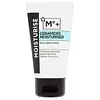What's inside
What's inside
 Key Ingredients
Key Ingredients

 Benefits
Benefits

 Concerns
Concerns

 Ingredients Side-by-side
Ingredients Side-by-side

Water
Skin ConditioningAluminum Starch Octenylsuccinate
AbsorbentGlycerin
HumectantPropylene Glycol
HumectantCetearyl Alcohol
EmollientPropanediol
SolventGlyceryl Stearate
EmollientButylene Glycol
HumectantSorbitan Stearate
EmulsifyingDimethicone
EmollientIsohexadecane
EmollientSodium Polyacrylate
AbsorbentPhenoxyethanol
PreservativeBetaine
HumectantCaprylyl Glycol
EmollientXanthan Gum
EmulsifyingPEG-100 Stearate
Sodium Lauroyl Lactylate
EmulsifyingSodium PCA
HumectantSodium Lactate
BufferingDisodium EDTA
Sodium Hyaluronate
HumectantTocopheryl Acetate
AntioxidantArginine
MaskingAspartic Acid
MaskingPCA
HumectantCeramide NP
Skin ConditioningGlycine
BufferingAlanine
MaskingCholesterol
EmollientCeramide AP
Skin ConditioningPhytosphingosine
Skin ConditioningSerine
MaskingValine
MaskingCarbomer
Emulsion StabilisingEthylhexylglycerin
Skin ConditioningIsoleucine
Skin ConditioningProline
Skin ConditioningThreonine
Histidine
HumectantPhenylalanine
MaskingCeramide EOP
Skin ConditioningWater, Aluminum Starch Octenylsuccinate, Glycerin, Propylene Glycol, Cetearyl Alcohol, Propanediol, Glyceryl Stearate, Butylene Glycol, Sorbitan Stearate, Dimethicone, Isohexadecane, Sodium Polyacrylate, Phenoxyethanol, Betaine, Caprylyl Glycol, Xanthan Gum, PEG-100 Stearate, Sodium Lauroyl Lactylate, Sodium PCA, Sodium Lactate, Disodium EDTA, Sodium Hyaluronate, Tocopheryl Acetate, Arginine, Aspartic Acid, PCA, Ceramide NP, Glycine, Alanine, Cholesterol, Ceramide AP, Phytosphingosine, Serine, Valine, Carbomer, Ethylhexylglycerin, Isoleucine, Proline, Threonine, Histidine, Phenylalanine, Ceramide EOP
Water
Skin ConditioningHelianthus Annuus Seed Oil
EmollientCoco-Caprylate/Caprate
EmollientAlcohol Denat.
AntimicrobialLanolin
EmollientGlycerin
HumectantPrunus Amygdalus Dulcis Oil
Skin ConditioningParfum
MaskingPolyglyceryl-4 Oleate
EmulsifyingBeeswax
Emulsion StabilisingMagnesium Sulfate
Polyglyceryl-6 Oleate
EmulsifyingPolyhydroxystearic Acid
EmulsifyingPhenoxyethanol
PreservativeSaccharide Isomerate
HumectantCaprylyl Glycol
EmollientArginine
MaskingTocopheryl Acetate
AntioxidantTetrasodium Glutamate Diacetate
Calendula Officinalis Extract
Skin ConditioningPisum Sativum Extract
Skin ConditioningAnthemis Nobilis Flower Extract
MaskingCitric Acid
BufferingSodium Citrate
BufferingLeuconostoc/Radish Root Ferment Filtrate
AntimicrobialRosmarinus Officinalis Leaf Extract
AntimicrobialPotassium Sorbate
PreservativeSodium Hydroxide
BufferingLimonene
PerfumingLinalool
PerfumingWater, Helianthus Annuus Seed Oil, Coco-Caprylate/Caprate, Alcohol Denat., Lanolin, Glycerin, Prunus Amygdalus Dulcis Oil, Parfum, Polyglyceryl-4 Oleate, Beeswax, Magnesium Sulfate, Polyglyceryl-6 Oleate, Polyhydroxystearic Acid, Phenoxyethanol, Saccharide Isomerate, Caprylyl Glycol, Arginine, Tocopheryl Acetate, Tetrasodium Glutamate Diacetate, Calendula Officinalis Extract, Pisum Sativum Extract, Anthemis Nobilis Flower Extract, Citric Acid, Sodium Citrate, Leuconostoc/Radish Root Ferment Filtrate, Rosmarinus Officinalis Leaf Extract, Potassium Sorbate, Sodium Hydroxide, Limonene, Linalool
 Reviews
Reviews

Ingredients Explained
These ingredients are found in both products.
Ingredients higher up in an ingredient list are typically present in a larger amount.
Arginine is an amino acid that is important for human development. Your body uses is it to produce hair keratin and skin collagen.
As a cosmetic ingredient, Arginine has antioxidant properties and can also help repair damaged skin. This ingredient is derived either synthetically or from animals.
Arginine isn't fungal acne safe when used in the presence of other lipids (fats, fatty acids, oils, esters, etc). Oils and fats occur naturally within the skin, so take caution when using Arginine if you're prone to fungal acne.
Learn more about ArginineCaprylyl Glycol is a humectant and emollient, meaning it attracts and preserves moisture.
It is a common ingredient in many products, especially those designed to hydrate skin. The primary benefits are retaining moisture, skin softening, and promoting a healthy skin barrier.
Though Caprylyl Glycol is an alcohol derived from fatty acids, it is not the kind that can dry out skin.
This ingredient is also used as a preservative to extend the life of products. It has slight antimicrobial properties.
Learn more about Caprylyl GlycolGlycerin is already naturally found in your skin. It helps moisturize and protect your skin.
A study from 2016 found glycerin to be more effective as a humectant than AHAs and hyaluronic acid.
As a humectant, it helps the skin stay hydrated by pulling moisture to your skin. The low molecular weight of glycerin allows it to pull moisture into the deeper layers of your skin.
Hydrated skin improves your skin barrier; Your skin barrier helps protect against irritants and bacteria.
Glycerin has also been found to have antimicrobial and antiviral properties. Due to these properties, glycerin is often used in wound and burn treatments.
In cosmetics, glycerin is usually derived from plants such as soybean or palm. However, it can also be sourced from animals, such as tallow or animal fat.
This ingredient is organic, colorless, odorless, and non-toxic.
Glycerin is the name for this ingredient in American English. British English uses Glycerol/Glycerine.
Learn more about GlycerinPhenoxyethanol is a preservative that has germicide, antimicrobial, and aromatic properties. Studies show that phenoxyethanol can prevent microbial growth. By itself, it has a scent that is similar to that of a rose.
It's often used in formulations along with Caprylyl Glycol to preserve the shelf life of products.
Tocopheryl Acetate is AKA Vitamin E. It is an antioxidant and protects your skin from free radicals. Free radicals damage the skin by breaking down collagen.
One study found using Tocopheryl Acetate with Vitamin C decreased the number of sunburned cells.
Tocopheryl Acetate is commonly found in both skincare and dietary supplements.
Learn more about Tocopheryl AcetateWater. It's the most common cosmetic ingredient of all. You'll usually see it at the top of ingredient lists, meaning that it makes up the largest part of the product.
So why is it so popular? Water most often acts as a solvent - this means that it helps dissolve other ingredients into the formulation.
You'll also recognize water as that liquid we all need to stay alive. If you see this, drink a glass of water. Stay hydrated!
Learn more about Water